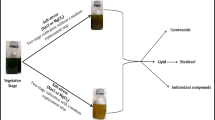Abstract
Photoheterotrophic and photoautotrophic cell suspension cultures were raised from a callus tissue derived from a Morinda lucida Benth. plant (Rubiaceae). The cultures were characterized with regard to fresh weight, dry weight, cell number, pH, chlorophyll and quinoid natural products. The amount of lipoquinones (phylloquinone, α-tocopherol, plastoquinone, ubiquinone) isolated from the photoautotrophic cultures matched the amount detected in an intact leaf. Anthraquinone glycosides which are found in the roots of Morinda plants were not present in the photoautotrophic culture. The photoheterotrophic culture contained only trace amounts of these pigments. Abundant anthraquinone synthesis was observed when photoautotrophic and photoheterotrophic suspension cultures were transferred into darkness, provided sucrose was present in the medium. Induction of synthesis of anthraquinone pigments coincided with a rapid disappearance of lipoquinones from the culture. Thus, in the suspension culture, photoautotrophy correlates with lipoquinone synthesis and heterotrophy correlates with anthraquinone synthesis. This reflects the situation in the intact plants where lipoquinones are chloroplast-associated whereas anthraquinones occur in the roots.
Similar content being viewed by others
Abbreviations
- HPLC:
-
high-performance liquid chromatography
References
Barz, W., Hüsemann, W. (1982) Aspects of photoautotrophic cell suspension cultures. In: Plant tissue culture 1982, pp. 245–248, Fujiwara A., ed. Maruzen Co., Tokyo
Bauch, H.-J., Leistner, E. (1978) Aromatic metabolites in cell suspension cultures of Galium mollugo L. Planta Med. 33, 105–123
Bishop, D.H.L., Pandya, K.P., King, H.K. (1962) Ubiquinone and vitamin K in bacteria. Biochem. J. 83, 606–614
Demagos, G.P., Baltus, W., Höfle, G. (1981) New anthraquinones and anthraquinone glycosides from Morinda lucida Z. Naturforsch. Teil B 86, 1180–1184
Foyer, C.H., Hall, D.O. (1980) Oxygen metabolism in the active chloroplast. Trends Biochem. Sci. 5, 188–191
Gamborg, O.L., Miller, R.A., Ojima, K. (1968) Nutrient requirement of suspension cultures of soybean root cells. Exp. Cell Res. 50, 151–158
Gaudillière, J.P., d'Harlingue, A., Camara, B., Mońeger, R. (1984) Prenylation and methylation reactions in phylloquinone (vitamin K1) synthesis in Capsicum annuum plastids. Plant Cell Rep. 3, 240–242
Heide, L., Arendt, S., Leistner, E. (1982) Enzymatic synthesis, characterization, and metabolism of the coenzyme A ester of o-succinylbenzoic acid, an intermediate in menaquinone (vitamin K2) biosynthesis. J. Biol. Chem. 257, 7396–7400
Hüsemann, W. (1982) Photoautotrophic growth of cell suspension cultures from Chenopodium rubrum in an airlift fermenter. Protoplasma 113, 214–220
Hüsemann, W., Barz, W. (1977) Photoautotrophic growth and photosynthesis in cell suspension cultures from Chenopodium rubrum. Physiol. Plant. 40, 77–81
Hüsemann, W., Plohr, A., Barz, W. (1979) Photosynthetic characteristics of photomixotrophic and photoautotrophic cell suspension cultures of Chenopodium rubrum Protoplasma 100, 101–112
Inoue, K., Shiobara, Y., Nageshiro, H., Inouye, H., Wilson, G., Zenk, M.H. (1984) Biosynthesis of anthraquinones and related compounds in Galium mollugo cell suspension cultures. Phytochemistry 23, 307–311
Inoue, K., Ueda, S., Shiobara, Y., Kimura, I. (neé Wada), Inouye, H. (1981) Quinones and related compounds in higher plants, Part 11. Role of 2-carboxy-2,3-dihydro-1,4-naphthoquinone and 2-carboxy-2-(3-methyl-but-2-enyl)-2,3 dihydro-1,4-naphthoquinone in the biosynthesis of naphthoquinone congeners of Catalpa ovata callus tissues. Chem. Soc. Perkin Trans. 1, 1246–1258
Kaiping, S., Soll, J., Schultz, G. (1984) Site of methylation of 2-phytyl-1,4-naphthoquinol in phylloquinone (vitamin K1) synthesis in spinach chloroplasts. Phytochemistry 23, 89–91
Knobloch, K.-H., Berlin, J. (1980) Influence of medium composition on the formation of secondary compounds in cell suspension cultures of Catharanthus roseus (L.) G. Don Z. Naturforsch. Teil C 35, 551–556
Kolkmann, R., Leistner, E. (1985) Synthesis and revised structure of the o-succinylbenzoic acid coenzyme A ester, an intermediate in menaquinone biosynthesis. Tetrahedron Lett. 26, 1703–1704
Kuhn, D.N., Chappell, J., Boudet, A., Hahlbrock, K. (1984) Induction of phenylalanine ammonia-lyase and 4-coumarate: CoA ligase mRNAs in cultured plant cells by UV light or fungal elicitor. Proc. Natl. Acad. Sci. USA 81, 1102–1106
Linsmaier, E.M., Skoog, F. (1965) Organic growth factor requirements of tobacco tissue cultures. Physiol. Plant. 18, 100–127
Mazliak, P., Benveniste, P., Costes, C., Douce, R. (1980) Biogenesis and function of plant lipids. Elsevier, North-Holland Biomedical Press, Amsterdam
Meganathan, R., Bentley, R. (1983) Thiamine pyrophosphate requirement for o-succinylbenzoic acid synthesis in Escherichia coli and evidence for an intermediate. J. Bacteriol. 153, 739–746
Morimoto, H., Iwada, I. (1971) Gas chromatography of ubiquinone and related quinones. Methods Enzymol. 18, part C, 169–179
Ramasarma, T., Jayaraman, J. (1971) Reverse-phase chromatographic separation of ubiquinone isoprenologs. Methods Enzymol. 18, part C, 165–169
Weische, A., Leistner, E. (1985) Cell free synthesis of o-succinylbenzoic acid from iso-chorismic acid, the key reaction in vitamin K2 (menaquinone) biosynthesis. Tetrahedron Lett. 26, 1487–1490
Zenk, M.H., El-Shagi, H., Schulte, U. (1975) Anthraquinone production by cell suspension cultures of Morinda citrifolia. Planta Med. Suppl. 79, 101
Ziegler, R., Egle, K. (1965) Zur quantitativen Analyse der Chloroplastenpigmente. Beitr. Biol. Pflanzen 41, 11–63
Author information
Authors and Affiliations
Rights and permissions
About this article
Cite this article
Igbavboa, U., Sieweke, HJ., Leistner, E. et al. Alternative formation of anthraquinones and lipoquinones in heterotrophic and photoautotrophic cell suspension cultures of Morinda lucida Benth.. Planta 166, 537–544 (1985). https://doi.org/10.1007/BF00391279
Received:
Accepted:
Issue Date:
DOI: https://doi.org/10.1007/BF00391279




